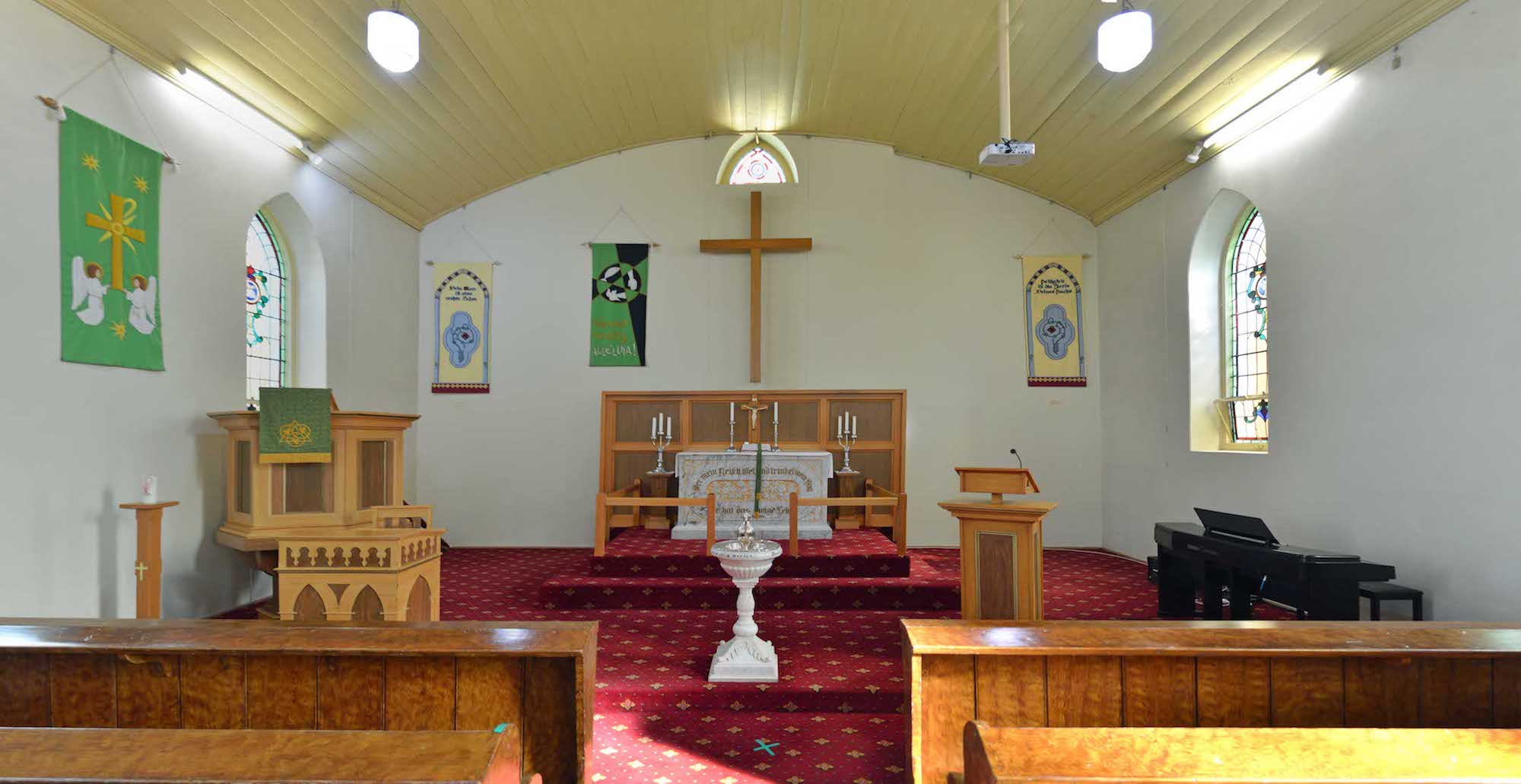
The six visible balcony texts are shown above. The translations from the King James Version of the Bible can be found in the small plaques arrayed beneath. They read (from top left): • Open unto me the gates of righteousness; I will go into them and I will praise the Lord. Psalm 118:19 ; • Lord I have loved the habitation of thy house, and the place where thine honour dwelleth. Psalm 26:8 ; • Enter into his gates with thanksgiving, and into his courts with praise: be thankful unto him, and bless his name. Psalm 100:4 • Holy, holy, holy is the Lord of Hosts; the whole earth is full of his glory. Isa 6:3 ; • The Lord shall be with thee an everlasting light, and thy God thy glory. Isa 60:19; • One generation shall praise thy works to another, and shall declare thy mighty acts. Psa 145:4 . PLAN
22. PAINTING

This painting called ‘It is finished’ hangs at the bottom of the balcony stairs. It is by Wilf Weaver, and was painted 1992–93. Artist Wilf Weaver lived from 1914 to 2001. His work can also be seen on the Church ceiling and on the balcony panels.
23. ORGAN PIPES
The organ in this Church was built by Daniel Heinrich Lemke in 1871 (according to an inscription on a wooden pipe) and is the earliest of his existing organs. According to a newspaper report, it was his third organ. The organ was formerly blown by foot treadles but an electric blower was added in 1966.
24. ORGAN CONSOLE
Four of Lemke’s organs are known to exist today – all in the same style with four octaves of keys on one manual with no pedals and foot treadles to pump the wind. The specifications were the same and none of his stop knobs had stop names on them, only pitches. He made his own wooden pipes but imported the metal ones.
25. WEST WINDOWS
There are two West windows facing out from the balcony. These have the same format as the other Church windows, and there are two different motifs: at left the hill of Golgotha with a cross of crucifixion, and at right the Nativity star.
26. SANCTUARY
We come down from the balcony, and proceed to examine the details of the sanctuary. In turn we shall look at the font, the pulpit and lectern, the banners, the high window, the central Cross and the altar.
27. THE FONT
The font with its silver jug is of the kind commonly found in the Valley churches. The text around the rim comes from Mark 16:16 (in German): ‘He that believeth and is baptised shall be saved (blessed).’
28. PULPIT AND LECTERN
The Church has smart matching wooden pulpit and lectern, with darker inset wooden panels. A matching desk is placed by the pulpit. Sunday by Sunday the Gospel is preached from the pulpit, and the Scripture read from the lectern.
29. BANNERS
Four banners add colour and interest to the sanctuary. From left: • two angels watch over the Cross; • the text above the floral decoration comes from Psalm 93:5 – ‘Your Word is a right teaching’; • this is a Trinity banner with the Father (hand reaching down), the Son (fish = ICHTHUS in Greek = Jesus Christ Son of God) ; • Holy Spirit (dove) ; • here the text reads ‘Holiness is the ornament of your house’ (Psalm 93:5).
30. HIGH WINDOW
High above the altar is this ‘triangular’ window with two arced sides and a flat base, depicting the seal or rose of Luther. Luther belived that this was a good symbol of his faith, and used it as a seal for his correspondence.
31. CENTRAL CROSS
It is not uncommon for Protestant churches to have a bare Cross as the focus of worship, but it seems to be less common for Lutheran churches. The Cross is a reminder that the Christ who was crucified rose again and is alive today.
32. ALTAR
The altar is at the front of the Church in the sanctuary area, and is partly surrounded by the altar rails. It is from here that the Eucharist is administered, and members come forward to the rails to receive the Elements. This altar appears to be quite elaborate in its design.
33. ALTAR DETAIL
The gold lettering on the altar spells out John 6:54: ‘Whoso eateth my flesh and drinketh my blood hath eternal life’. We know this altar dates from 1901. It is a very smart altar!
34. CRUCIFIX AND OPEN BIBLE
We have come to expect the crucifix and open Bible on the altar in these Lutheran churches, and the Holy Cross Church does not disappoint. The crucifix is unusual though, with the Christ figure in the throes of crucifixion, almost expressing a victorious outcome.
35. CEMETERY
Leaving the Church we make our way down behind to view the cemetery. From here we can see that the Church does stand on a small rise. The cemetery is well cared for, and sheltered by a belt of trees. This concludes our visit to the Holy Cross Gruenberg Church.

CONCLUSION
I hope you have enjoyed visiting the Holy Cross Gruenberg Lutheran Church with me. Although there are similarities shared by the Barossa Valley churches, Holy Cross has some distinctive features, perhaps clinging more strongly to its German heritage.
My thanks to Pastor Rob Borgas who gave up several hours of his holiday to escort us around his churches.
I am very happy to receive any corrections or constructive comments about this site: the best websites are those which have no errors! I am grateful to my wife Margie who came with me and who has done much valuable proof reading.
Holy Cross Church has a website address with link:
http://gruenberg.lutheran.org.au/
The photos on this site are all mine, and can also be found in higher resolution at:
https://www.flickr.com/photos/paulscottinfo/albums/
Site created: 08 / 2020
Paul Scott













